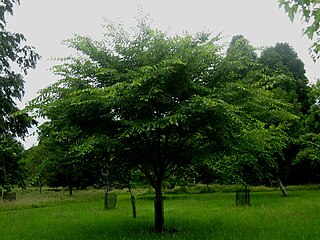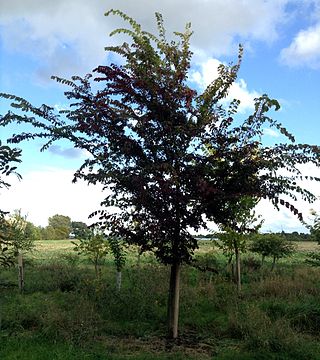
Ulmus davidiana var. japonica, the Japanese elm, is one of the larger and more graceful Asiatic elms, endemic to much of continental northeast Asia and Japan, where it grows in swamp forest on young alluvial soils, although much of this habitat has now been lost to intensive rice cultivation.

Ulmus 'New Horizon' is an American hybrid cultivar raised by the Wisconsin Alumni Research Foundation (WARF), from a crossing of the Japanese Elm clone W43-8 = 'Reseda' with Siberian Elm clone W426 grown from seed collected from a street tree at Yankton, South Dakota. Tested in the US National Elm Trial coordinated by Colorado State University, 'New Horizon' averaged a survival rate of 74% after 10 years.'New Horizon' was patented in the US in 1994, while in Europe, it is marketed as one of the 'Resista' elms protected under EU breeders' rights.

Ulmus laciniata(Trautv.) Mayr, known variously as the Manchurian, cut-leaf, or lobed elm, is a deciduous tree native to the humid ravine forests of Japan, Korea, northern China, eastern Siberia and Sakhalin, growing alongside Cercidiphyllum japonicum, Aesculus turbinata, and Pterocarya rhoifolia, at elevations of 700–2200 m, though sometimes lower in more northern latitudes, notably in Hokkaido.

Ulmus macrocarpaHance, the large-fruited elm, is a deciduous tree or large shrub endemic to the Far East excluding Japan. It is notable for its tolerance of drought and extreme cold and is the predominant vegetation on the dunes of the Khorchin sandy lands in the Jilin province of north-eastern China, making a small tree at the base of the dunes, and a shrub at the top.

Ulmus davidiana, also known as the David elm, or Father David elm, is a small deciduous tree widely distributed across China, Mongolia, Korea, Siberia, and Japan, where it is found in wetlands along streams at elevations of 2000–2300 m (6,500–7,500 ft). The tree was first described in 1873 from the hills north of Beijing, China.
Ulmus pseudopropinquaWang & Li, occasionally known in the United States as the Harbin spring elm, is a small deciduous tree found only in Heilongjiang, the northeasternmost province in China. The tree has not been studied comprehensively, and it has been speculated it may be a natural hybrid of Ulmus davidiana var. japonica and Ulmus macrocarpa.

Ulmus szechuanicaFang, known as the Szechuan (Sichuan), or red-fruited, elm, is a small to medium deciduous Chinese tree found along the Yangtze river through the provinces of Sichuan, Jiangxi, Anhui, and Jiangsu.

Ulmus 'Frontier' is an American hybrid cultivar, a United States National Arboretum introduction derived from a crossing of the European Field Elm Ulmus minor with the Chinese Elm Ulmus parvifolia in 1971. Released in 1990, the tree is a rare example of the hybridization of spring- and autumn-flowering elms. Tested in the US National Elm Trial coordinated by Colorado State University, 'Frontier' averaged a survival rate of 74% after 10 years.

Ulmus 'Homestead' is an American hybrid elm cultivar raised by Alden Townsend of the United States National Arboretum at the Nursery Crops Laboratory in Delaware, Ohio. The cultivar arose from a 1970 crossing of the Siberian Elm Ulmus pumila with the hybrid N 215, the latter grown from seed sent in 1960 to the University of Wisconsin-Madison elm breeding team by Hans Heybroek of the De Dorschkamp Research Institute in the Netherlands. Tested in the US National Elm Trial coordinated by Colorado State University, 'Homestead' averaged a survival rate of 85% after 10 years. 'Homestead' was released to commerce without patent restrictions in 1984.

The hybrid elm cultivar Ulmus × hollandica 'Pioneer' is an American clone arising from the crossing of two European species, Wych Elm U. glabra and Field Elm U. minor. Raised by the USDA station at Delaware, Ohio, in 1971, 'Pioneer' was released to commerce in 1983.

Ulmus gausseniiW. C. Cheng, the Anhui, or hairy, elm, is a medium size deciduous tree whose natural range is restricted to the valleys of the Langya limestone mountains of Chu Xian in Anhui Province, eastern China. The tree was most commonly found on the flood plains, indicating a tolerance of periodic inundation. However, U. gaussenii is now possibly the rarest and most endangered elm species, with only approximately 30 trees known to survive in the wild in 2009.

Ulmus 'Morton Glossy' is a hybrid cultivar raised by the Morton Arboretum, Illinois. Originally named 'Charisma' until it was realized that name had already been registered for another plant, the tree was derived from a crossing of two other hybrid cultivars grown at the Morton: Accolade and Vanguard. Tested in the US National Elm Trial coordinated by Colorado State University, Triumph averaged a survival rate of 86% after 10 years. Triumph was introduced to the UK in 2006 by the Frank P. Matthews nursery in Worcestershire.
Ulmus 'Morton Plainsman' is a hybrid cultivar raised by the Morton Arboretum from a crossing of Siberian Elm and a Japanese Elm grown from openly pollinated seed donated by the Agriculture Canada Research Station at Morden, Manitoba. Tested in the US National Elm Trial coordinated by Colorado State University, Vanguard averaged a survival rate of 78% after 10 years.

Ulmus 'Morton Red Tip' is a hybrid cultivar raised by the Morton Arboretum from an open pollination of Ulmus 'Morton'. The tree has occasionally been reported as a hybrid of Accolade with the Siberian Elm Ulmus pumila, an error probably owing to the commercial propagation of the tree by grafting onto U. pumila rootstocks. Tested in the US National Elm Trial coordinated by Colorado State University, Danada Charm averaged a survival rate of 77.5% after 10 years.

Ulmus 'Morton Stalwart', is a Morton Arboretum hybrid cultivar arising from a controlled crossing of Accolade with the hybrid of a Field Elm U. minor from eastern Russia and a Siberian Elm U. pumila. Tested in the US National Elm Trial coordinated by Colorado State University, Commendation averaged a survival rate of 85% after 10 years.

The American Elm cultivar Ulmus americana 'Princeton' was originally selected in 1922 by New Jersey nurseryman William Flemer of Princeton Nurseries for its aesthetic merit. 'Princeton' was later found to have a moderate resistance to Dutch elm disease (DED).

The American Elm cultivar Ulmus americana 'Valley Forge' was raised by the Agricultural Research Service in Maryland. The tree was released to wholesale nurseries without patent restrictions by the U. S. National Arboretum in 1995 after proving to have a high resistance to Dutch elm disease. 'Valley Forge' proved only moderately successful in the US National Elm Trial, averaging a survival rate of 66.7% overall, owing largely to environmental factors rather than susceptibility to disease.

The American elm cultivar Ulmus americana 'New Harmony' was raised by the Maryland Agricultural Research Service and released by the United States National Arboretum in 1995, along with 'Valley Forge'. 'New Harmony' proved the most successful U. americana cultivar in the US National Elm Trial, averaging a survival rate of 85.5% overall.

The Japanese elm cultivar Ulmus davidianavar.japonica 'Prospector' was originally treated as a cultivar of Wilson's elm U. wilsonianaSchneid., a species sunk as Ulmus davidiana var. japonica by Fu. A U.S. National Arboretum introduction, it was selected in 1975 from a batch of 1965 seedlings in Delaware, Ohio, and released without patent restrictions in 1990. 'Prospector' proved moderately successful in the US National Elm Trial, averaging a survival rate of 76% overall.

Ulmus 'Patriot' is a hybrid cultivar raised by the United States National Arboretum in 1980. Derived from a crossing of the American hybrid 'Urban' with the Wilson's Elm cultivar 'Prospector', 'Patriot' was released to commerce, free of patent restrictions, in 1993. Tested in the US National Elm Trial coordinated by Colorado State University, 'Patriot' averaged a survival rate of 85% after 10 years.





















